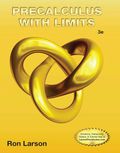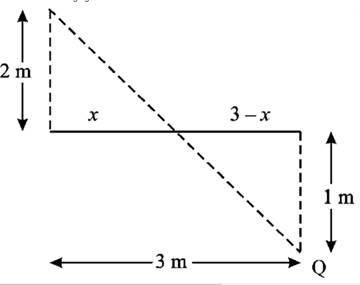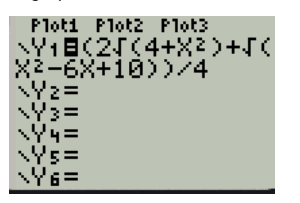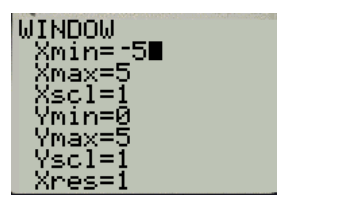
Concept explainers
(a)
The total time
(a)
Answer to Problem 10PS
The total time of the trip as the function of
Explanation of Solution
Given:
Consider the layout of the given diagram is shown in Figure 1

Figure 1
Calculation:
The speed at which the boat travelled per hour is
Since the boat is moving at the speed of
The distance travelled by walking is,
The speed of walking is
Then, the total time taken to reach the point Q is,
Then,
(b)
The domain of the function.
(b)
Answer to Problem 10PS
The domain of the function is all the real numbe.
Explanation of Solution
Calculation:
The total time taken of the trip is,
The value of
(c)
The graph for the function.
(c)
Answer to Problem 10PS
The graph is shown in Figure 4
Explanation of Solution
Calculation:
To graph the function enter the function in Ti-83=as follows,

Figure 2
The second step is to choose the appropriate window,

Figure 3
The third step is to press the graph button as,

Figure 4
(d)
The values of the variable
(d)
Answer to Problem 10PS
The value of the variable is
Explanation of Solution
Calculation:
On the calculator after obtaining the graph press the trace button to button to obtain the point where the
The required graph is,

Figure 5
The maximum value of the function is
(e)
The brief paragraph to interrupt the values.
(e)
Answer to Problem 10PS
The minimum total time taken for the distance of 1 mile is
Explanation of Solution
The minimum time
Chapter 1 Solutions
EBK PRECALCULUS W/LIMITS
- A 20 foot ladder rests on level ground; its head (top) is against a vertical wall. The bottom of the ladder begins by being 12 feet from the wall but begins moving away at the rate of 0.1 feet per second. At what rate is the top of the ladder slipping down the wall? You may use a calculator.arrow_forwardExplain the focus and reasons for establishment of 12.4.1(root test) and 12.4.2(ratio test)arrow_forwarduse Integration by Parts to derive 12.6.1arrow_forward
- Explain the relationship between 12.3.6, (case A of 12.3.6) and 12.3.7arrow_forwardExplain the key points and reasons for the establishment of 12.3.2(integral Test)arrow_forwardUse 12.4.2 to determine whether the infinite series on the right side of equation 12.6.5, 12.6.6 and 12.6.7 converges for every real number x.arrow_forward
- use Corollary 12.6.2 and 12.6.3 to derive 12.6.4,12.6.5, 12.6.6 and 12.6.7arrow_forwardExplain the focus and reasons for establishment of 12.5.1(lim(n->infinite) and sigma of k=0 to n)arrow_forwardExplain the focus and reasons for establishment of 12.5.3 about alternating series. and explain the reason why (sigma k=1 to infinite)(-1)k+1/k = 1/1 - 1/2 + 1/3 - 1/4 + .... converges.arrow_forward
 Calculus: Early TranscendentalsCalculusISBN:9781285741550Author:James StewartPublisher:Cengage Learning
Calculus: Early TranscendentalsCalculusISBN:9781285741550Author:James StewartPublisher:Cengage Learning Thomas' Calculus (14th Edition)CalculusISBN:9780134438986Author:Joel R. Hass, Christopher E. Heil, Maurice D. WeirPublisher:PEARSON
Thomas' Calculus (14th Edition)CalculusISBN:9780134438986Author:Joel R. Hass, Christopher E. Heil, Maurice D. WeirPublisher:PEARSON Calculus: Early Transcendentals (3rd Edition)CalculusISBN:9780134763644Author:William L. Briggs, Lyle Cochran, Bernard Gillett, Eric SchulzPublisher:PEARSON
Calculus: Early Transcendentals (3rd Edition)CalculusISBN:9780134763644Author:William L. Briggs, Lyle Cochran, Bernard Gillett, Eric SchulzPublisher:PEARSON Calculus: Early TranscendentalsCalculusISBN:9781319050740Author:Jon Rogawski, Colin Adams, Robert FranzosaPublisher:W. H. Freeman
Calculus: Early TranscendentalsCalculusISBN:9781319050740Author:Jon Rogawski, Colin Adams, Robert FranzosaPublisher:W. H. Freeman
 Calculus: Early Transcendental FunctionsCalculusISBN:9781337552516Author:Ron Larson, Bruce H. EdwardsPublisher:Cengage Learning
Calculus: Early Transcendental FunctionsCalculusISBN:9781337552516Author:Ron Larson, Bruce H. EdwardsPublisher:Cengage Learning





